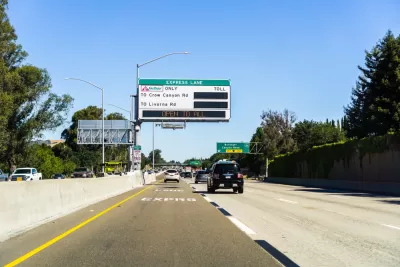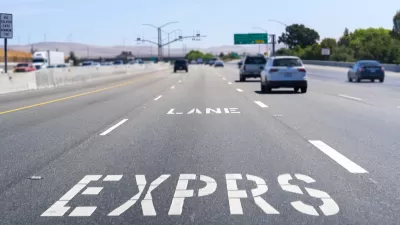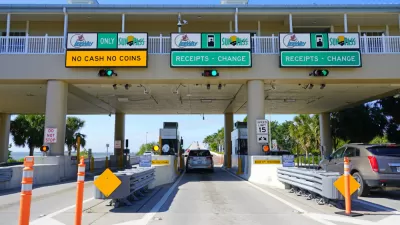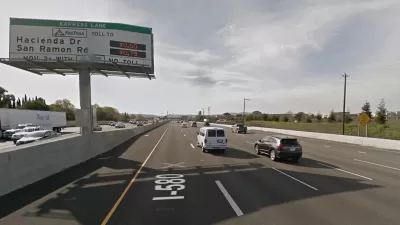What's more surprising is seeing who is making the proposal and why. The first step would be to have the concept included in Plan Bay Area 2050.

Express or high-occupancy toll (HOT) lanes that apply congestion pricing to solo-occupant vehicles are found throughout Northern and Southern California and many other states. While controversial, they almost always can be found adjacent to general purpose, or unmanaged, unpriced lanes, an exception being the 66 Express Lanes Inside the Beltway in Northern Virginia, and then only during peak hours when all lanes are "HOT," providing solo motorists the option of paying for a faster trip or "travel as usual."
An exclusive report from Zachary Clark of the San Mateo Daily Journal indicates that highway paradigm could change for freeways with "robust transit options" if operators of Bay Area Express Lanes in Alameda, San Francisco, San Mateo, and Santa Clara counties agree with a letter from the Metropolitan Transportation Commission (MTC) asking that the "concept" be included in a regional planning process known as Plan Bay Area 2050 [italics added]:
According to a letter dated Aug. 1, the Metropolitan Transportation Commission wants to eventually implement congestion pricing on all lanes of many if not most Bay Area freeways...To lower greenhouse gas emissions, MTC envisions the “eventual transition to congestion pricing on all freeway lanes in corridors with robust transit options,” according to the letter and adds “express lanes can be a stepping stone to more extensive congestion pricing strategies.”
Transportation is far and away the primary source of greenhouse gas emissions in California, responsible for 41 percent of emissions according to the latest California Greenhouse Gas Emission Inventory, having increased for the fifth consecutive year in 2017.
MTC is asking the nine Bay Area counties to sign off on the letter, including the above plan for freeway tolling so it can be included in the Plan Bay Area 2050 draft blueprint. For most major transportation projects to proceed from conception to implementation, inclusion in that plan is a key requirement.
The MTC letter can be found in the Aug. 14, 2020, meeting notice [pdf] for the San Mateo County Express Lanes Joint Powers Authority (SMCEL-JPA). (See agenda item 5.3: "Authorize the Executive Council to sign off a letter to the Metropolitan Transportation Commission supporting the Bay Area Express Lanes Project Performance Strategies as included in Plan Bay Area 2050 Draft Blueprint. Action, page 10.")
Omitted in the source article is the general prohibition on the imposition of tolls on existing federal-aid highways with exceptions for new lanes and conversions of existing carpool lanes. In December 2018, the Oregon Department of Transportation submitted an application to the Federal Highway Administration to toll all lanes on portions of two Portland metro area interstates under a federal pilot program for value pricing tolling. Metro, the metropolitan planning organization for the Portland region, "is collecting information to determine if congestion pricing can reduce traffic and greenhouse gas emissions and increase safety and equity" as part of its regional congestion pricing study.
Correspondent's note: A big thank you to Clark, the Daily Journal reporter, for emailing the link to the SMCEL-JPA meeting notice so readers can verify that there really is a proposal, of sorts, from a U.S. metropolitan planning organization to turn freeways into tollways in order to reduce greenhouse gas emissions.
Related in Planetizen:
-
Plan Bay Area 2050 Draft Released, July 23, 2020
-
Wyoming Legislation Would Add Tolls to Interstate 80, January 17, 2020
-
Managed Lanes Coming to the San Francisco Peninsula, March 13, 2019
-
Interstate Highway Tolling Takes Major Step Forward in Pacific Northwest, December 9, 2018
FULL STORY: New highway tolling eyed in Bay Area

Alabama: Trump Terminates Settlements for Black Communities Harmed By Raw Sewage
Trump deemed the landmark civil rights agreement “illegal DEI and environmental justice policy.”

Planetizen Federal Action Tracker
A weekly monitor of how Trump’s orders and actions are impacting planners and planning in America.

The 120 Year Old Tiny Home Villages That Sheltered San Francisco’s Earthquake Refugees
More than a century ago, San Francisco mobilized to house thousands of residents displaced by the 1906 earthquake. Could their strategy offer a model for the present?

Opinion: California’s SB 79 Would Improve Housing Affordability and Transit Access
A proposed bill would legalize transit-oriented development statewide.

Record Temperatures Prompt Push for Environmental Justice Bills
Nevada legislators are proposing laws that would mandate heat mitigation measures to protect residents from the impacts of extreme heat.

Downtown Pittsburgh Set to Gain 1,300 New Housing Units
Pittsburgh’s office buildings, many of which date back to the early 20th century, are prime candidates for conversion to housing.
Urban Design for Planners 1: Software Tools
This six-course series explores essential urban design concepts using open source software and equips planners with the tools they need to participate fully in the urban design process.
Planning for Universal Design
Learn the tools for implementing Universal Design in planning regulations.
Clanton & Associates, Inc.
Jessamine County Fiscal Court
Institute for Housing and Urban Development Studies (IHS)
City of Grandview
Harvard GSD Executive Education
Toledo-Lucas County Plan Commissions
Salt Lake City
NYU Wagner Graduate School of Public Service





























